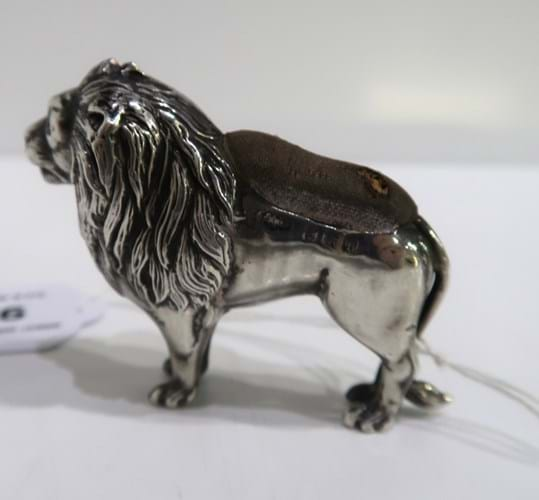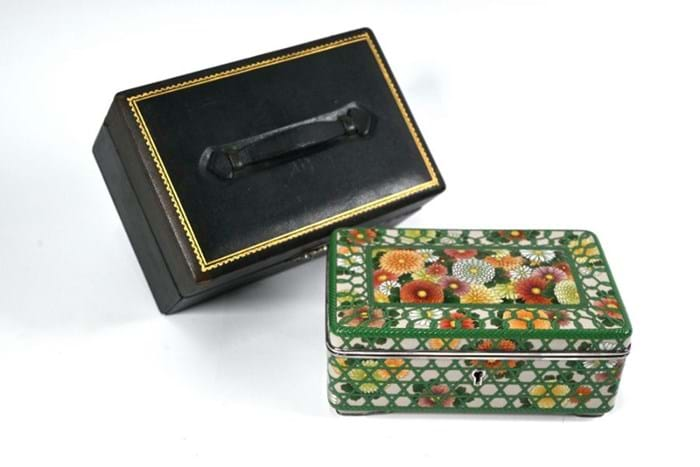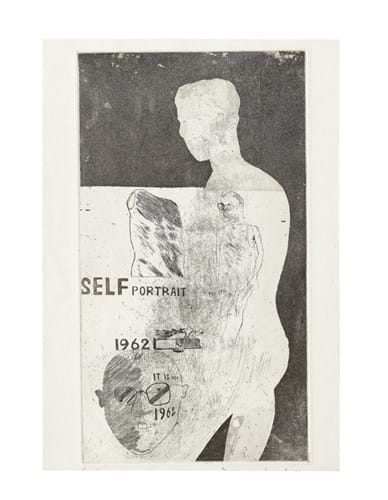1. Lion pin cushion
Appealing to a range of different types of collectors, Victorian and Edwardian animals pin cushions have their own niche in the novelty silver field. Some, such as chicks, pigs and elephants are relatively easy to find. Others, such as foxes, cows and camels, were made in much smaller numbers. Among the rarest of all forms is the lion, measuring just over 6cm long, made in the first decade of the 20th century by specialist Birmingham smallwork maker Adie & Lovekin. The company, pin cushion specialist, was founded in 1889 by Alfred Lovekin (1844-1912) and James Adie (1840-1913).and based from the 1890s at a factory at 23 Frederick Street.
Just how pricey these can be was demonstrated at Great Western Auctions in Glasgow on December 15. This 1910 example, in good condition save two areas of wear to the pad, was guided at just £80-120 but sparked a contest that ended only at £1600.
As for disappointed underbidders there is at least a chance to buy another. The silver sale at Woolley & Wallis in Salisbury on January 25-26 has an Adie & Lovekin lion pin cushion dated 1908 with a guide of £600-800.
2. Cloisonne casket
This Japanese cloisonne casket bears the mark for the Ando Company of Nagoya. Much of the firm’s success was based on the technical innovations introduced by the master Kawade Shibataro (1856-c.1921), one of the four great masters of Japanese cloisonné, along with Namikawa Yasuyuki, Namikawa Sosuke and Hayashi Kodenji.
Kewade’s most important contribution to this golden age of Meiji cloisonne was moriage (piling-up). This painstaking technique, involving the building up layers of enamel to produce a three-dimensional effect, can be seen to good effect on this box that was offered for sale at Andrew Smith & Son in Alresford, Winchester on December 15. Sold in its original silk-lined box with the maker’s label, it was estimated at £250-300 but sold at £7000
3. Hockney etching
There are only three other known examples of this early David Hockney (b.1937) etching dating from 1962. One proof is currently located in the collection of the artist and a second is owned by the Tate Gallery.
The artist made the work in his final year at the Royal College of Art in London. Entitled Self Portrait, the etching humorously dances around theme of ‘the ideal versus the real self. A muscular male nude, that bears little resemblance to Hockney, dominates the image while a much smaller, much less-muscular figure wearing glasses is superimposed over the top.
A previously unrecorded proof, it was offered for sale at Bonhams’ Prints & Multiples sale December 16 with a guide of £7000-10,000 but sold at £40,000.
4. Chess set
Sometimes in the niche market of chess collectables, the box can be almost as important as its contents.
The sale at Dawsons in Maidenhead on December 16 included an early Staunton pattern set by Hatton Garden purveyor of fine games John Jaques. These, the first Jaques sets advertised in the Illustrated London News dated September 8, 1849, were sold in two types of ‘packaging’: dovetailed mahogany hinged-topped boxes and ‘the unique box of carton-pierre resembling richly carved ebony’.
Designed by one Joseph L Williams, these Gothic revival caskets are distinctive for their castellated corners and pierced chess piece decoration and were available in three sizes.
In the first two years of Staunton production, the boxes carried paper registration labels titled The Staunton Chessmen that were hand signed and numbered by English chess master Howard Staunton (1810-74). Up to 1000 sets were signed in this way before a facsimile signature was used.
The example at Dawsons was, like many survivors, in far from perfect condition but it was largely intact and retained its original contents, a standard boxwood and ebony set priced at the time at £1/15 shillings.
Offered together with two further Staunton style chess sets in wooden boxes, the lot had a guide of just £150-250 but sold for £4600.
5. Otter amulet
This 19th century sea otter amulet fashioned walrus ivory and baleen fashioned as an otter and her pup sold for £24,000 at the Woolley & Wallis sale of Tribal Art and Antiquities in Salisbury on December 15. It was one of two similar 19th century Inuit carvings in the sale each estimated at £4000-6000.
These rare sculptures, carved to show a sea otter in characteristic feeding posture, on its back with hands raised to mouth, were fastened inside the cockpit of Inuit and Aleut kayaks. It was thought they would bring good fortune when hunting otters for fur – a primary source of income for Arctic peoples in the 19th century. This 8cm example appears to be particularly unusual as it features both an adult sea otter and her pup.










